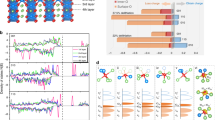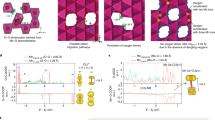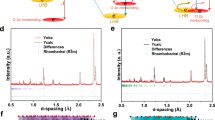Abstract
Lithium-ion batteries are now reaching the energy density limits set by their electrode materials, requiring new paradigms for Li+ and electron hosting in solid-state electrodes. Reversible oxygen redox in the solid state in particular has the potential to enable high energy density as it can deliver excess capacity beyond the theoretical transition-metal redox-capacity at a high voltage. Nevertheless, the structural and chemical origin of the process is not understood, preventing the rational design of better cathode materials. Here, we demonstrate how very specific local Li-excess environments around oxygen atoms necessarily lead to labile oxygen electrons that can be more easily extracted and participate in the practical capacity of cathodes. The identification of the local structural components that create oxygen redox sets a new direction for the design of high-energy-density cathode materials.
This is a preview of subscription content, access via your institution
Access options
Subscribe to this journal
Receive 12 print issues and online access
$259.00 per year
only $21.58 per issue
Buy this article
- Purchase on Springer Link
- Instant access to full article PDF
Prices may be subject to local taxes which are calculated during checkout




Similar content being viewed by others
References
Goodenough, J. B. & Park, K.-S. The Li-ion rechargeable battery: a perspective. J. Am. Chem. Soc. 135, 1167–1176 (2013).
Lee, J. et al. Unlocking the potential of cation-disordered oxides for rechargeable lithium batteries. Science 343, 519–522 (2014).
Sathiya, M. et al. Reversible anionic redox chemistry in high-capacity layered-oxide electrodes. Nature Mater. 12, 827–835 (2013).
Gallagher, K. G. et al. Quantifying the promise of lithium-air batteries for electric vehicles. Energy Environ. Sci. 7, 1555–1563 (2014).
Kang, B. & Ceder, G. Battery materials for ultrafast charging and discharging. Nature 458, 190–193 (2009).
Kang, K., Meng, Y. S., Breger, J., Grey, C. P. & Ceder, G. Electrodes with high power and high capacity for rechargeable lithium batteries. Science 311, 977–980 (2006).
Mizushima, K., Jones, P. C., Wiseman, P. J. & Goodenough, J. B. LixCoO2 (0 ≤ x ≤ −1): a new cathode material for batteries of high energy density. Mater. Res. Bull. 15, 783–789 (1980).
Ohzuku, T., Ueda, A., Nagayama, M., Iwakoshi, Y. & Komori, H. Comparative study of LiCoO2, LiNi1/2Co1/2O2 and LiNiO2 for 4 volt secondary lithium cells. Electrochim. Acta 38, 1159–1167 (1993).
Lu, Z., MacNeil, D. D. & Dahn, J. R. Layered Li[NixCo1−2xMnx]O2 cathode materials for lithium-ion batteries. Electrochem. Solid-State Lett. 4, A200–A203 (2001).
Aydinol, M. K., Kohan, A. F., Ceder, G., Cho, K. & Joannopoulos, J. Ab initio study of lithium intercalation in metal oxides and metal dichalcogenides. Phys. Rev. B 56, 1354 (1997).
Ceder, G. et al. Identification of cathode materials for lithium batteries guided by first-principles calculations. Nature 392, 694–696 (1998).
Yoon, W.-S. et al. Oxygen contribution on Li-ion intercalation–deintercalation in LiCoO2 investigated by O K-edge and Co L-edge X-ray absorption spectroscopy. J. Phys. Chem. B 106, 2526–2532 (2002).
Yoon, W.-S. et al. Investigation of the charge compensation mechanism on the electrochemically Li-ion deintercalated Li1–xCo1/3Ni1/3Mn1/3O2 electrode system by combination of soft and hard X-ray absorption spectroscopy. J. Am. Chem. Soc. 127, 17479–17487 (2005).
Graetz, J. et al. Electronic structure of chemically-delithiated LiCoO2 studied by electron energy-loss spectrometry. J. Phys. Chem. B 106, 1286–1289 (2002).
Dahéron, L. et al. Electron transfer mechanisms upon lithium deintercalation from LiCoO2 to CoO2 investigated by XPS. Chem. Mater. 20, 583–590 (2008).
Yoon, W.-S. et al. Combined NMR and XAS study on local environments and electronic structures of electrochemically Li-ion deintercalated Li1−xCo1/3Ni1/3 Mn1/3O2 electrode system. Electrochem. Solid-State Lett. 7, A53–A55 (2004).
Koga, H. et al. Reversible oxygen participation to the redox processes revealed for Li1.20Mn0.54Co0.13Ni0.13O2 . J. Electrochem. Soc. 160, A786–A792 (2013).
Yabuuchi, N. et al. High-capacity electrode materials for rechargeable lithium batteries: Li3NbO4-based system with cation-disordered rocksalt structure. Proc. Natl Acad. Sci. USA 112, 7650–7655 (2015).
Goodenough, J. B. & Kim, Y. Challenges for rechargeable Li batteries. Chem. Mater. 22, 587–603 (2010).
Kohn, W. & Sham, L. J. Self-consistent equations including exchange and correlation effects. Phys. Rev. 140, A1133 (1965).
Heyd, J., Scuseria, G. E. & Ernzerhof, M. Hybrid functionals based on a screened Coulomb potential. J. Chem. Phys. 118, 8207–8215 (2003).
Seo, D.-H., Urban, A. & Ceder, G. Calibrating transition metal energy levels and oxygen bands in first principles calculations: accurate prediction of redox potentials and charge transfer in lithium transition metal oxides. Phys. Rev. B 92, 115118 (2015).
Ohzuku, T. & Makimura, Y. Layered lithium insertion material of LiCo1/3Ni1/3 Mn1/3O2 for lithium-ion batteries. Chem. Lett. 30, 642–643 (2001).
Cho, Y. & Cho, J. Significant improvement of LiNi0.8Co0.15Al0.05O2 cathodes at 60 °C by SiO2 dry coating for Li-ion batteries. J. Electrochem. Soc. 157, A625–A629 (2010).
Lu, Z. H., MacNeil, D. D. & Dahn, J. R. Layered cathode materials Li[NixLi(1/3–2x/3) Mn(2/3–x/3)]O2 for lithium-ion batteries. Electrochem. Solid-State Lett. 4, A191–A194 (2001).
Xiao, R., Li, H. & Chen, L. Density functional investigation on Li2MnO3 . Chem. Mater. 24, 4242–4251 (2012).
Lee, E. & Persson, K. A. Structural and chemical evolution of the layered Li-excess LixMnO3 as a function of Li content from first-principles calculations. Adv. Energy Mater. 4, 1400498 (2014).
Sathiya, M. et al. High performance Li2Ru1–yMnyO3 (0.2 ≤ y ≤ 0.8) cathode materials for rechargeable lithium-ion batteries: their understanding. Chem. Mater. 25, 1121–1131 (2013).
Wang, R. et al. A new disordered rock-salt Li-excess material with high capacity: Li1.25Nb0.25Mn0.5O2 . Electrochem. Commun. 60, 70–73 (2015).
Lee, J. et al. A new class of high capacity cation-disordered oxides for rechargeable lithium batteries: Li-Ni-Ti-Mo oxides. Energy Environ. Sci. 8, 3255–3265 (2015).
Petersburg, C. F., Li, Z., Chernova, N. A., Whittingham, M. S. & Alamgir, F. M. Oxygen and transition metal involvement in the charge compensation mechanism of LiNi1/3Mn1/3Co1/3O2 cathodes. J. Mater. Chem. 22, 19993–20000 (2012).
Ballhausen, C. J. Ligand Field Theory (McGraw Hill, 1962).
Oishi, M. et al. Charge compensation mechanisms in Li1.16Ni0.15Co0.19Mn0.50O2 positive electrode material for Li-ion batteries analyzed by a combination of hard and soft X-ray absorption near edge structure. J. Power Sources 222, 45–51 (2013).
Pauling, L. The Nature of the Chemical Bond Vol. 3 (Cornell Univ. Press, 1960).
Ashcroft, N. W. & Mermin, N. D. Solid State Physics 490–495 (Holt, Rinehart and Winston, 1976).
McCalla, E. et al. Understanding the roles of anionic redox and oxygen release during electrochemical cycling of lithium-rich layered Li4FeSbO6 . J. Am. Chem. Soc. 137, 4804–4814 (2015).
Saubanere, M., McCalla, E., Tarascon, J. M. & Doublet, M. L. The intriguing question of anionic redox in high-energy density cathodes for Li-ion batteries. Energy Environ. Sci. 9, 984–991 (2016).
Morrison, S. The Chemical Physics of Surfaces (Springer, 2012).
Zhang, L. et al. Synthesis and electrochemistry of cubic rocksalt Li–Ni–Ti–O compounds in the phase diagram of LiNiO2–LiTiO2–Li[Li1/3Ti2/3]O2 . J. Power Sources 185, 534–541 (2008).
Shigemura, H., Tabuchi, M., Sakaebe, H., Kobayashi, H. & Kageyama, H. Lithium extraction and insertion behavior of nanocrystalline Li2TiO3–LiFeO2 solid solution with cubic rock salt structure. J. Electrochem. Soc. 150, A638–A644 (2003).
Glazier, S. L., Li, J., Zhou, J., Bond, T. & Dahn, J. R. Characterization of disordered Li(1+x)Ti2xFe(1–3x)O2 as positive electrode materials in Li-ion batteries using percolation theory. Chem. Mater. 27, 7751–7756 (2015).
Lias, S. Ionization energy search, NIST chemistry webbook, NIST standard reference database 69 (2005); http://webbook.nist.gov/chemistry/ie-ser.html
Kresse, G. & Furthmuller, J. Efficiency of ab-initio total energy calculations for metals and semiconductors using a plane-wave basis set. Comput. Mater. Sci. 6, 15–50 (1996).
Acknowledgements
This work was supported by Robert Bosch Corporation and Umicore Specialty Oxides and Chemicals, and by the Assistant Secretary for Energy Efficiency and Renewable Energy, Office of Vehicle Technologies of the US Department of Energy under contract no. DE-AC02–05CH11231, under the Batteries for Advanced Transportation Technologies (BATT) Program subcontract no. 7056411. This work used the Extreme Science and Engineering Discovery Environment (XSEDE), which is supported by National Science Foundation grant no. ACI-1053575, and resources of the National Energy Research Scientific Computing Center (NERSC), a DOE Office of Science User Facility supported by the Office of Science of the US Department of Energy under contract no. DE-C02-05CH11231. D.-H.S. acknowledges support from the Basic Science Research Program through the National Research Foundation of Korea (NRF) funded by the Ministry of Education (2014R1A6A3A03056034). J.L. acknowledges financial support from a Samsung Scholarship.
Author information
Authors and Affiliations
Contributions
G.C. planned the project, supervised all aspects of the research, contributed to the main theory and to writing the manuscript. D.-H.S. and J.L. conceived and designed project details. D.-H.S. performed DFT calculations. D.-H.S. and J.L. analysed the data. J.L. and D.-H.S. developed the main theory and authored the manuscript. D.-H.S and J.L. contributed equally to this work. A.U. and S.Y.K. performed preliminary DFT calculations. A.U. and R.M. assisted in data analysis and in writing the manuscript.
Corresponding author
Ethics declarations
Competing interests
The authors declare no competing financial interests.
Supplementary information
Supplementary information
Supplementary information (PDF 1546 kb)
Rights and permissions
About this article
Cite this article
Seo, DH., Lee, J., Urban, A. et al. The structural and chemical origin of the oxygen redox activity in layered and cation-disordered Li-excess cathode materials. Nature Chem 8, 692–697 (2016). https://doi.org/10.1038/nchem.2524
Received:
Accepted:
Published:
Issue Date:
DOI: https://doi.org/10.1038/nchem.2524
This article is cited by
-
Structurally robust lithium-rich layered oxides for high-energy and long-lasting cathodes
Nature Communications (2024)
-
Enhanced cyclic stability of partially disordered spinel cathodes through direct fluorination with gaseous fluorine
Rare Metals (2024)
-
Highly structural stability from small-sized Li2MnO3-like domains in Co-free Li-rich layered oxide cathodes
Journal of Solid State Electrochemistry (2024)
-
Mn-based cathode materials for rechargeable batteries
Science China Chemistry (2024)
-
Design principles for NASICON super-ionic conductors
Nature Communications (2023)



